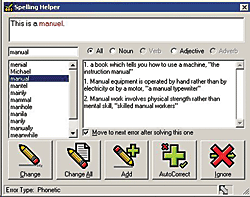
I recently presented on Primary Literacy and ICT at the Michigan Council for Exceptional Children Conference in Grand Rapids, Michigan, demonstrating assistive technology systems and discussing how technology can impact literacy throughout the school experience. Here's an excerpt. - Ira Socol
How can technology help?
With simple personal computer based solutions teachers can use technology to increase "read-to" time, allow students to work with sophisticated stories that might hold their interest, engage them more actively in the world of books, and improve student access to informational text and thus content learning. Technology can also provide skill-building support for phonological awareness, word shape recognition, and the understanding of how sounds in English translate into English spelling.
The classroom computer, properly equipped can "multiply" the teacher, by providing "non-staffed" support in these situations.
What types of technology will help?
Technology can dramatically increase "read-to" time: WYNN, TextHelp Read and Write Gold, Microsoft Reader, Kurzweil 3000, all allow a book to be read to students. The student sees and hears the specific word as it is read (the word is highlighted, in WYNN and Kurzweil the sentence can also be "sub-highlighted"). This reinforces reading skills just like "mom" sitting with the child and reading to them. Any book can be scanned in to WYNN or Kurzweil (complete with illustrations), any Word document can be converted into Microsoft Reader – a more limited, but wonderfully effective and completely free software package.
Technology can enhance the connection between word shape and word sound: WYNN, TextHelp Read and Write Gold, Microsoft Reader, Kurzweil 3000, by linking the word's shape-image to its sound builds this essential reading skill and allows dramatic improvements in new vocabulary acquisition. WYNN, and to a slightly lesser extent Kurzweil, also add in dictionaries, thesauruses, and other grammatical tools.
Technology can offer direct confirmation of the connection between sounds and spelling in English: ViaVoice, an IBM voice-to-text solution, allows a student with low phonological skills to dictate to the computer and watch the words appear. Thus, saying a word will reveal its spelling. The software does require unique voice training for every student, but may offer the possibility of dramatically improving language understanding.
Technology can offer content, information-reading, access to non-readers, pre-readers, and weak readers: WYNN, TextHelp Read and Write Gold, Microsoft Reader, Kurzweil 3000, all provide students with book reading possibilities that might otherwise be out-of-reach. This can allow students to not just keep up with content-area learning, but to investigate informational texts that match up with the student's unique interests.
Technology can offer sophisticated story access to non-readers, pre-readers, and weak readers: WYNN, TextHelp Read and Write Gold, Microsoft Reader, Kurzweil 3000, allow student reading groupings based in affinity instead of specific reading capabilities. This also allows students to work on comprehension issues as they work on decoding issues.
Technology can offer full web access to non-readers, pre-readers, and weak readers: WYNN, FoxyVoice (in the Firefox browser), and other tools allow students to engage in web research and web-based communication at levels equal to their classmates with stronger reading skills.
Technology can provide testing accommodations: WYNN's Test Talker can read tests and record student answers. WYNN itself, through it's notetaking component can do the same. So can TextHelp Read and Write Gold. Even Microsoft Reader can, if tests are converted from Word, allow notes to be added, thus providing testing possibilities (though Reader cannot accept spoken answers the way WYNN and Test Talker can).
No comments:
Post a Comment